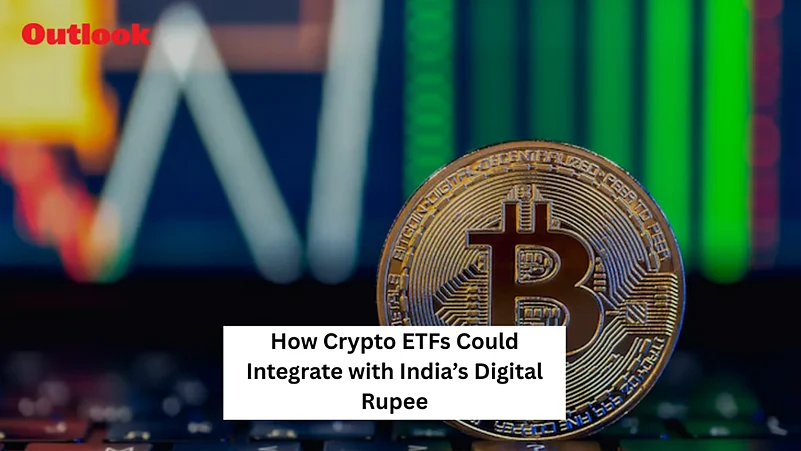India's financial landscape is set for a paradigm shift. With the Reserve Bank of India (RBI) launching the Digital Rupee and growing international interest in crypto exchange-traded funds (ETFs), many are speculating how these two technologies could coexist. Could they complement each other or will they be welcome in different corners of the financial universe?
What Is a Crypto ETF?
A Crypto ETF, or Exchange-Traded Fund, is a financial product that enables individuals to invest in cryptocurrencies but not directly purchase the digital currency itself. The ETF just follows the price of one or several cryptocurrencies, such as Bitcoin or Ethereum. Investors may purchase and sell the fund's shares on stock exchanges just like regular stocks.
This method provides a regulated and safer method of investing in the crypto space, particularly for those who are not at ease dealing with digital purses or private keys. It also enables wider market access, such as institutional investors who prefer traditional financial instruments rather than direct exposure to crypto.
What Is the Digital Rupee?
The Digital Rupee, also called the Central Bank Digital Currency (CBDC), is the government-backed digital currency of India. The Digital Rupee, unlike Bitcoin or Ethereum, is not decentralized. The RBI issues and governs it just like physical cash, but in digital currency form.
This digital currency is designed to make payments simpler, lower transaction costs, and streamline the banking system. The RBI has already implemented pilot schemes in wholesale and retail segments to test it.
Can Crypto ETFs and the Digital Rupee Function Together?
The concept of cross-matching two disparate financial innovations may sound complicated, but there are indeed a number of means by which Crypto ETFs and the Digital Rupee may intersect. This is how their merge might take place:
Easier Access to Crypto Investments
One key advantage of the Digital Rupee may be the simplified buying of financial products, such as ETFs. If laws permit, Indian investors can potentially use the Digital Rupee to invest directly in Crypto ETFs on government-regulated stock exchanges. This would potentially make crypto investing quicker, safer, and more transparent.
For instance, just like how individuals in the present utilize the UPI (Unified Payments Interface) to invest in stocks or mutual funds, the Digital Rupee might be utilized for investing in ETFs. This would eliminate the requirement of money conversion to other forms and enhance transaction speed and transparency.
Increased Regulatory Control
As the Digital Rupee will be issued by the RBI, all transactions can be tracked and logged. This may assist in bringing improved regulatory over crypto-based investments. Investing through a government-backed currency to invest in ETFs will enable authorities to ensure improved compliance with anti-money laundering regulations and tax policies.
This would also allow the government to understand better how individuals are engaging with crypto markets, and hence regulations can be molded easier for the future.
Better Settlement Speeds and Lower Transaction Costs
These days, the purchase of crypto assets requires several middlemen like brokers, banks, and payment processors that contribute to settlement charges and time. The Digital Rupee can eliminate these charges to a great extent by facilitating instant settlement between the stock exchange or ETF issuer and the investor.
Such an efficient process can benefit retail as well as institutional investors and induce more participation in the crypto investment platform.
Increasing Financial Inclusion
India also has a significant population which is under-served by the conventional banking system. The Digital Rupee, when combined with mobile platforms, may make it easier for citizens in rural and semi-urban regions to invest in crypto ETFs.
Even retail investors might be able to gain access to crypto assets without needing to comprehend sophisticated trading platforms or overseas exchanges. Existing digital infrastructure of the government like Aadhaar and UPI might allow onboarding and investment to be as easy as it gets.
Challenges to Consider
While the potential is exciting, some challenges must be overcome.
To start with, there needs to be regulatory clarity. So far, crypto ETFs are not approved in India. SEBI and the RBI would have to collaborate closely in order to come up with guidelines that make the investor safe but at the same time promote innovation.
Second, proper education and awareness among the public are needed. Most still have no proper idea what an ETF or even the Digital Rupee is. Without financial education, users could abuse or refrain from using these instruments.
Lastly, issues of cybersecurity and privacy have to be treated with utmost care. Increased vulnerability to hacking or data misappropriation is brought about by the use of digital currencies and digital investments. Strong systems and rigid policies will be required to forestall fraud or financial tampering.
Conclusion
India is at a fascinating crossroads. On one hand, the Digital Rupee, which is a central bank initiative to streamline money itself. On the other, the global emergence of Crypto ETFs is transforming the way investors interact with digital assets. While both are as yet on different tracks, the future may see them converge.
If India opens up Crypto ETFs and makes use of the Digital Rupee as a medium of transaction, it may usher in a new era of financial inclusion and modernization of markets. This fusion may bring to an end the disconnect between conventional finance and the crypto universe and provide Indian investors a secure, efficient, and government-sanctioned means of tapping into the potential of digital assets.
With the regulatory and financial environments in constant flux, the next few years might tell the tale of how well India can harmonize innovation with responsibility in this dynamic environment.














